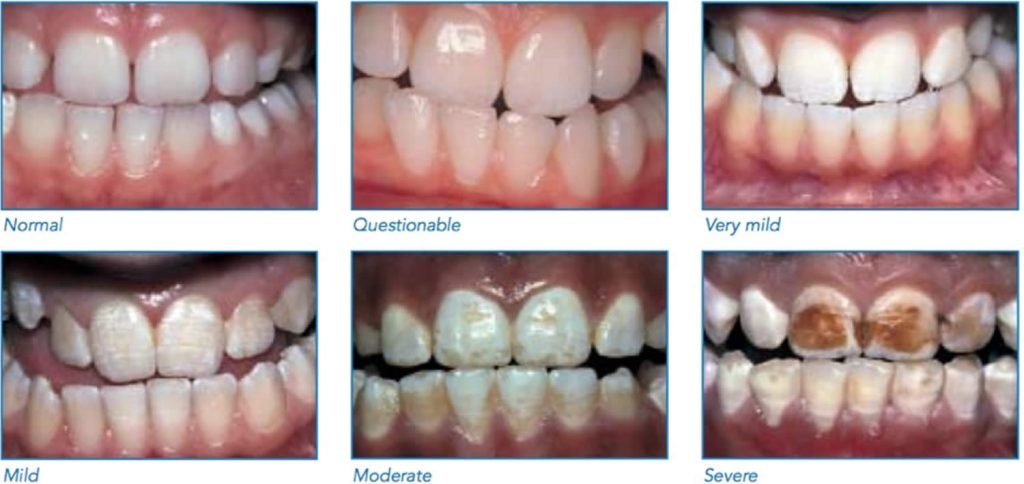
Fluorosis : Causes and Treatment
Fluorosis is a dental and skeletal condition that occurs due to excessive intake of fluoride over a prolonged period.
Dental fluorosis or mottled teeth is marked by increased porosity of the enamel of teeth (a condition known as “hypomineralization“). In the “moderate” and severe forms of fluorosis, the enamel’s porosity increases to such an extent that the teeth can begin to erode and crumble.
Teeth with moderate and severe fluorosis also have very pronounced staining which can deeply disfigure a child’s smile.
Although fluoride is beneficial in preventing tooth decay, excessive exposure can lead to fluorosis.
Causes of Fluorosis
Fluorosis primarily occurs due to the ingestion of high levels of fluoride, typically through water, food, or even dental products. The following factors contribute to the development of fluorosis:
- High Fluoride Levels in Water: Drinking water with elevated fluoride concentrations, usually above the recommended level of 0.7-1.2 parts per million (ppm), is a significant cause of fluorosis. Certain regions may have naturally occurring fluoride-rich water sources, while in others, excessive fluoride may result from industrial pollution or incorrect water treatment.
- Excessive Fluoride Consumption: Consumption of fluoride-rich products, such as fluoride supplements, fluoride-fortified foods, or fluoride-based dental hygiene products (toothpaste, mouth rinses), can contribute to fluorosis when used excessively or by young children who may inadvertently swallow these substances.
Treatment of Fluorosis
The treatment options for fluorosis depend on the severity of the condition. Here are some common approaches:
- Prevention and Monitoring: Prevention plays a crucial role in managing fluorosis. Measures include:
- Monitoring Fluoride Intake: Regularly assessing the fluoride content in drinking water and ensuring it falls within the recommended range.
- Oral Hygiene Practices: Encouraging proper brushing techniques with an appropriate amount of fluoride toothpaste, especially for young children who are more prone to swallowing toothpaste.
- Dietary Considerations: Emphasizing a balanced diet that avoids excessive consumption of fluoride-rich foods and beverages.
- Minimally Invasive Dental Procedures: For mild to moderate cases of fluorosis, various cosmetic dental procedures can help improve the appearance of affected teeth. These may include:
- Microabrasion: A procedure that involves the removal of a thin layer of enamel to eliminate surface stains and discoloration. (Rs 2000 – Rs 8000)
- Dental Bonding: The application of tooth-colored resin to cover or reshape affected teeth, improving their aesthetic appearance. (Rs 2500 – Rs 4000)
- Veneers: Thin porcelain shells bonded to the front surface of teeth to mask stains and discoloration. (Rs 4500 – Rs 15000)
- Dental Crowns or Veneers: For severe cases of fluorosis, where the enamel is significantly damaged, dental crowns or veneers can provide a more comprehensive and long-lasting solution. These restorations can improve the shape, color, and overall appearance of affected teeth.
Conclusion: Mottled Teeth
Fluorosis is a condition that arises due to excessive fluoride exposure over a prolonged period. Preventive measures, such as monitoring fluoride intake and maintaining good oral hygiene practices, play a vital role in managing this condition.
For mild to moderate cases, minimally invasive dental procedures like microabrasion, dental bonding, or veneers can improve the appearance of affected teeth. Severe cases may require more extensive treatments like dental crowns or veneers.
Consulting with a dental professional is essential to determine the most appropriate treatment plan based on the severity of fluorosis and individual needs.
Book Fluorosis Treatment Consultation
Check Cost of Dental Procedures in India

Dr. Jyoti Singh (MDS), Diplomate WICO (Japan region) stands as a beacon of excellence in implantology within Delhi NCR region. She is a BDS and MDS(Prostho) both from Maulana Azad Institute of Dental Sciences, where she secured top honors with all India rank 1 in PG entrance examination. Her extensive experience at esteemed institutions like Clove Dental and her own Center for Dental Implants & Esthetics since 2016, Dr. Singh embodies unparalleled expertise in dental implants. Boasting a wealth of 16 years in dentistry and backed by 18 groundbreaking research papers in leading international journals (Google Scholar) and her ResearchGate profile, she epitomizes the pinnacle of proficiency and innovation in her field. She practices in Gurugram as your friendly dentist near me.
